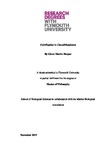Calcification in Coccolithophores
| dc.contributor.supervisor | Moate, Roy Martin | |
| dc.contributor.author | Harper, Glenn Martin | |
| dc.contributor.other | School of Biological and Marine Sciences | en_US |
| dc.date.accessioned | 2017-03-21T14:38:52Z | |
| dc.date.issued | 2017 | |
| dc.identifier | 924714 | en_US |
| dc.identifier.uri | http://hdl.handle.net/10026.1/8664 | |
| dc.description | Chapter 3 forms the basis of the publication; Dynamics of formation and secretion of heterococcoliths by Coccolithus pelagicus ssp. Braarudii. Taylor, A.R, Russell, M.A, Harper. G.M, Collins, T. and Brownlee C. (2007). | en_US |
| dc.description.abstract |
Abstract Coccolithophores are uni-cellular phytoplankton and they form an exceedingly diverse group in the phylum Haptophyta. They produce highly complex structures known as coccoliths by a biomineralisation process known as calcification. The first part of the work undertaken was to investigate the process of calcification in the coccolithophore Coccolithus pelagicus using a combination of Transmission Electron Microscopy (TEM), Scanning Electron Microscopy (SEM) and light microscopy techniques. This allowed better understanding of the formation, transit of the coccolith through the cell until its final placing in the coccosphere. The second part of the work looked at the coccolithophore Emiliania huxleyi which is divided into several morphotypes with the two most widely recognised being A and B, it can be further subdivided into further groups according to genotype by Coccolithophore Morphology Motif (CMM). The CMMs lie in the 3/ untranslated region of the coccolith-polysaccharide associated protein-GPA, which is associated with coccolith structure control and they are labelled I, II, III and IV. The work undertaken used a Scanning Electron Microscope (SEM) to investigate the morphologies of homozygous CMM I and CMMIV cell’s coccoliths. This information was used to establish a significant difference between the CMMI cells and CMMIV cells but only at certain locations. The cause for this is possibly as a result of several factors (temperature, salinity, pCO2, Ca availability and light levels) and requires further investigation. | en_US |
| dc.language.iso | en | |
| dc.publisher | University of Plymouth | |
| dc.rights | CC0 1.0 Universal | * |
| dc.rights.uri | http://creativecommons.org/publicdomain/zero/1.0/ | * |
| dc.subject | Coccolithophores calcification | en_US |
| dc.subject.classification | MPhil | en_US |
| dc.title | Calcification in Coccolithophores | en_US |
| dc.type | Thesis | |
| plymouth.version | publishable | en_US |
| dc.identifier.doi | http://dx.doi.org/10.24382/666 | |
| dc.rights.embargodate | 2018-03-21T14:38:52Z | |
| dc.rights.embargoperiod | 12 months | en_US |
| dc.type.qualification | Masters | en_US |
| rioxxterms.version | NA | |
| plymouth.orcid_id | N/A | en_US |
Files in this item
This item appears in the following Collection(s)
-
01 Research Theses Main Collection
Research Theses Main



